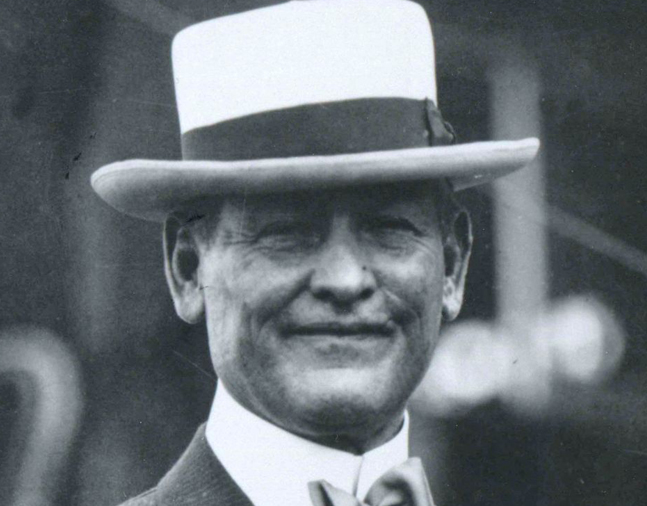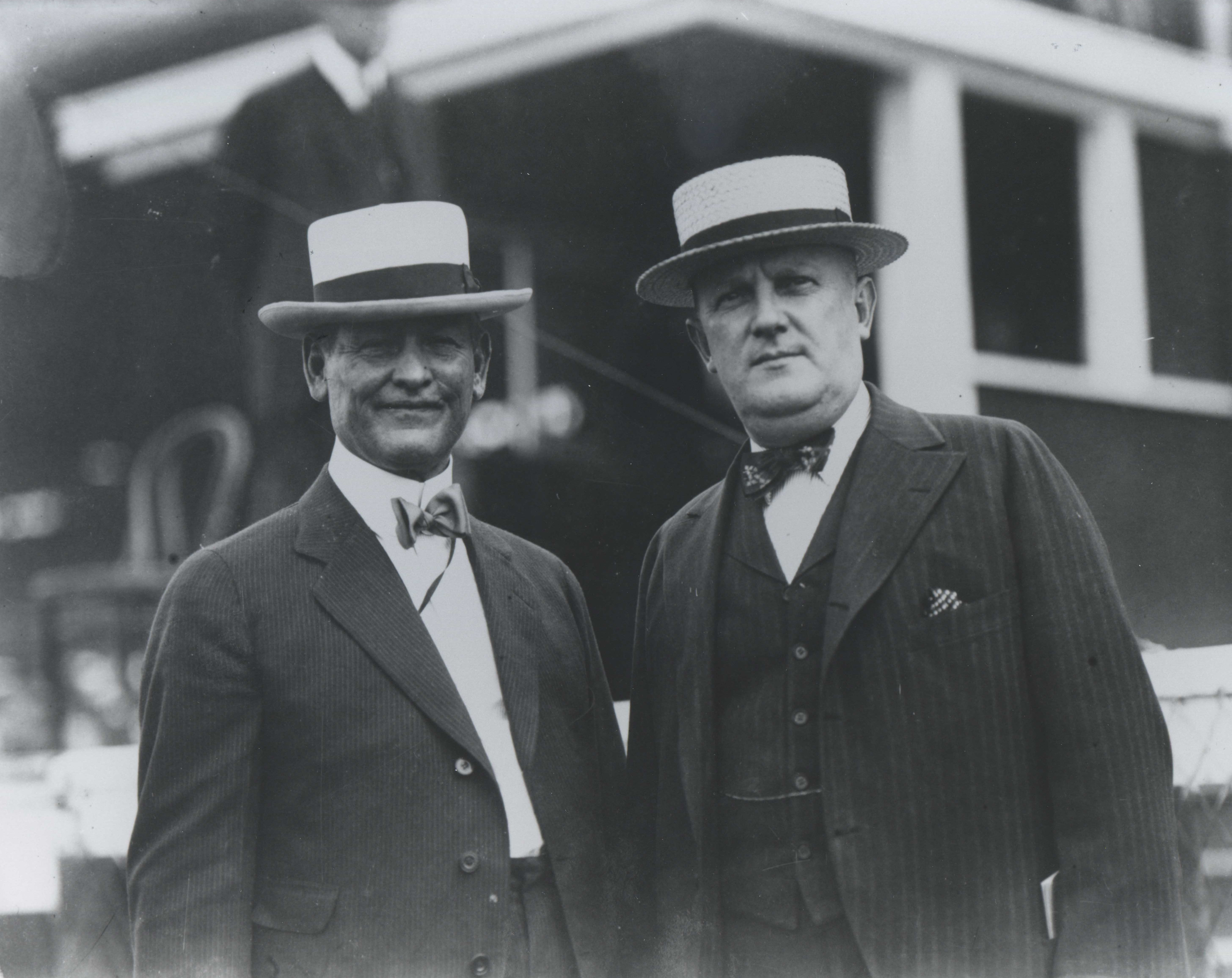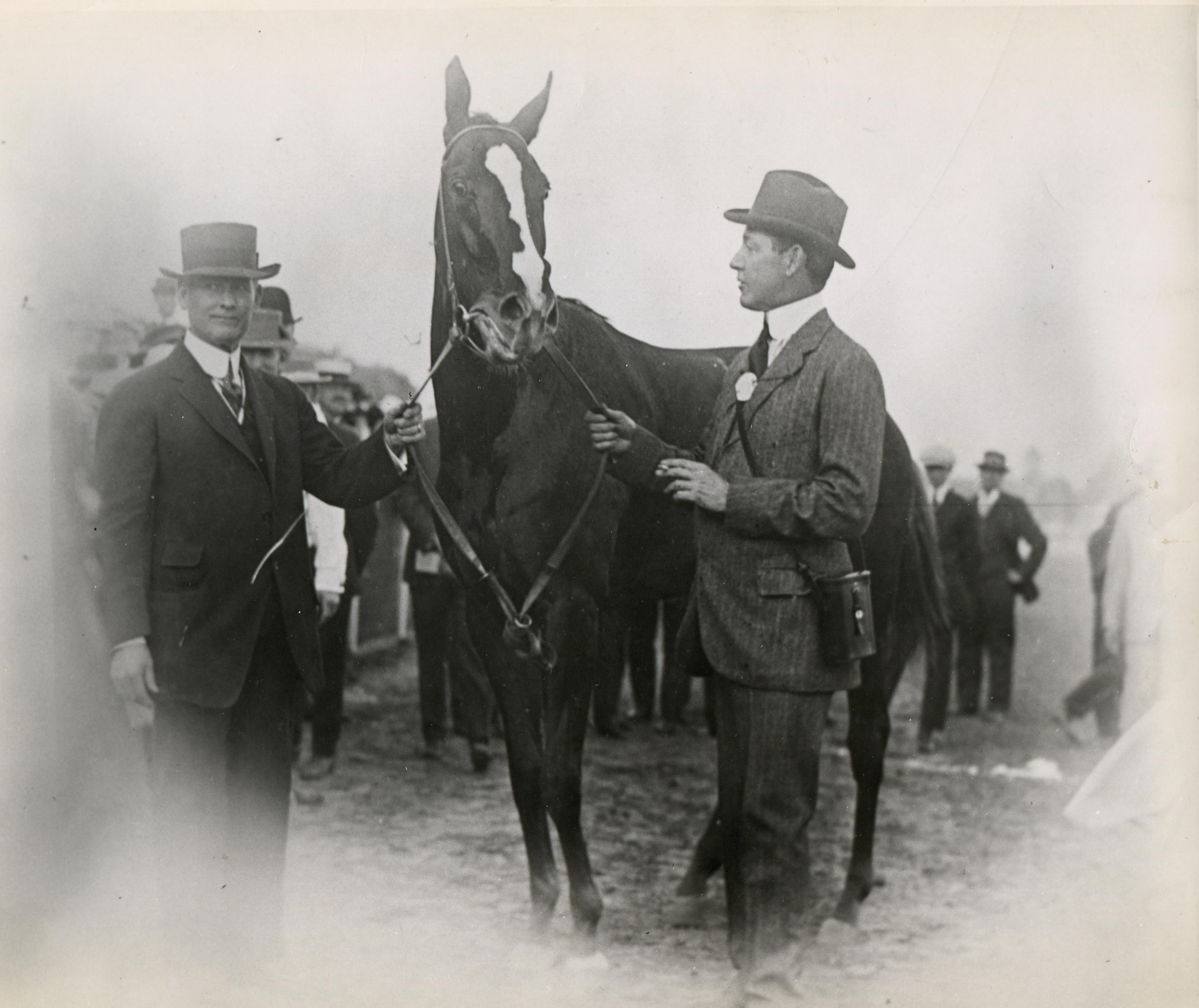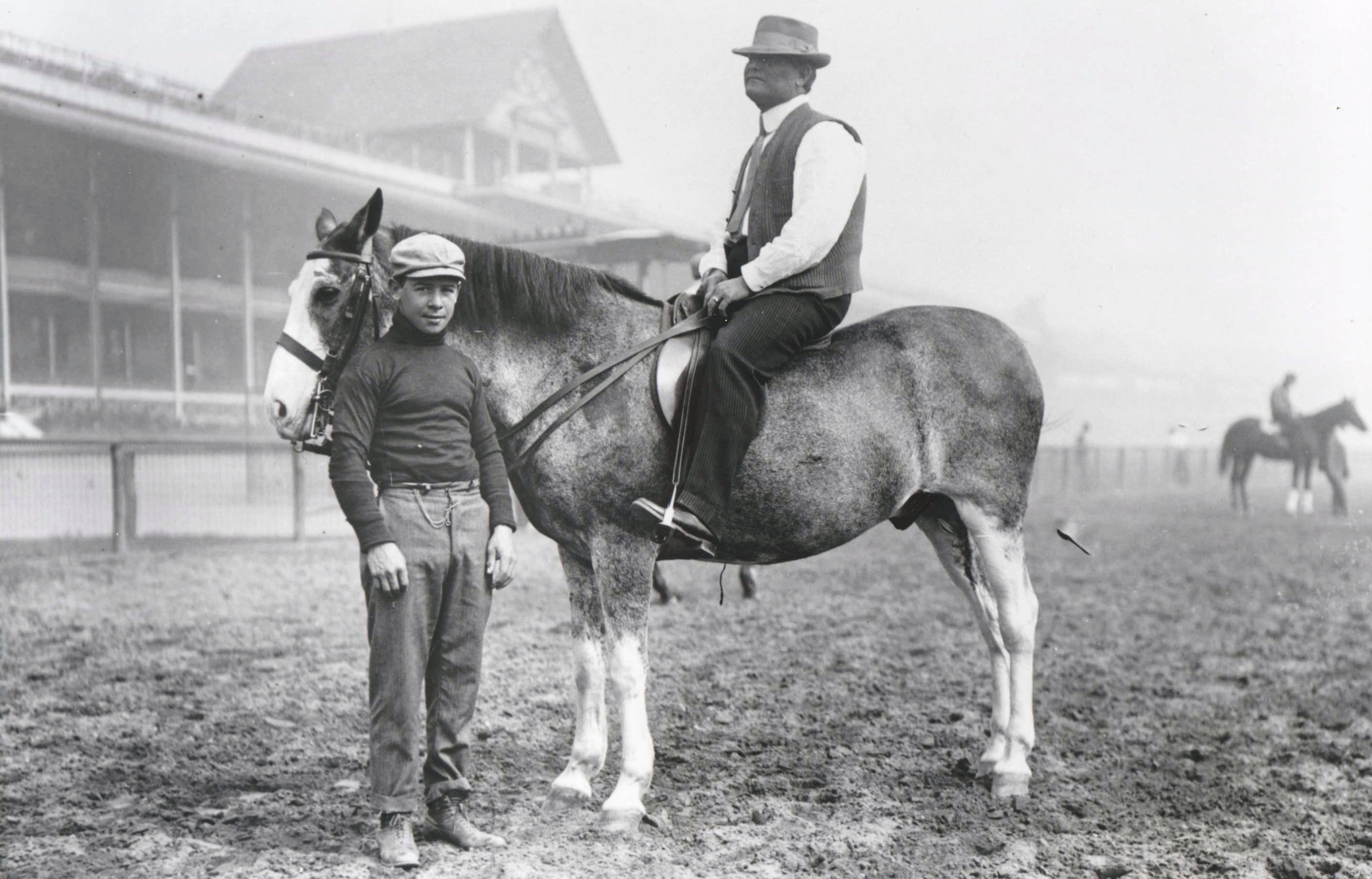James G. Rowe Sr.
James Gordon Rowe was one of the finest jockeys in America during the 1870s, winning such prestigious races as the Belmont, Travers, Saratoga Cup, and Jerome Handicap. He was the nation’s leading rider from 1871 through 1873, and became the regular jockey — at the age of 14 — for one of the greatest horses of the 19th century, Harry Bassett.

1955
1857, Richmond, Virginia
Aug. 2, 1929, Saratoga Springs, New York
1878-1929
Biography
James Gordon Rowe was one of the finest jockeys in America during the 1870s, winning such prestigious races as the Belmont, Travers, Saratoga Cup, and Jerome Handicap. He was the nation’s leading rider from 1871 through 1873, and became the regular jockey — at the age of 14 — for one of the greatest horses of the 19th century, Harry Bassett.
As distinguished as they are, Rowe’s achievements in the irons are a mere footnote in a much bigger story. When he could no longer make weight as a jockey, Rowe made the transition to training thoroughbreds, which proved to be his life’s calling.
In a training career that spanned 50 years, Rowe established himself as arguably the most accomplished conditioner of racehorses in American history. He developed more champions (34) and Hall of Fame members (10) than any other individual in the sport’s annals. Rowe won every major event in America, including a record eight runnings of the Belmont, a race he also won twice as a jockey. He also won multiple editions of the Futurity (nine), Alabama (seven), Brooklyn Handicap (six), Saratoga Special (five), Manhattan Handicap (five), Gazelle (five), Dwyer (four), Hopeful (four), Metropolitan Handicap (three), Travers (three), and Kentucky Derby (two), among others.
Rowe was born in Richmond, Virginia, in 1857. At the age of 10, he was working at a newsstand at the Exchange Hotel in Richmond when he was spotted by Col. David McDaniel, who invited the youngster into his stable as an apprentice rider. By the time he was 14, Rowe had demonstrated a rare combination of strength and finesse in the saddle, as well as a tremendous sense of timing. Those skills convinced McDaniel that Rowe was the ideal pilot for the great Harry Bassett. It was a perfect pairing. As a 3-year-old in 1871, Harry Bassett was undefeated in nine starts. Rowe was aboard for victories in the Jerome, Kenner, and Dixie, among others.
Rowe made quite a name for himself in 1871. At Jerome Park, McDaniel put him aboard a talented 3-year-old colt named Abd-El-Koree in a four-mile race. Rowe, who could ride at 95 pounds, broke quickly to get the lead on Helmbold and Billy Lakeland, a famous jockey of the day. Helmbold closed the gap late, but Rowe and Abd-El-Koree held on to win by a neck and set a world record of 7:33 for a 3-year-old at the distance. One contemporary account described Rowe as “holding Koree together with the skill of a veteran” and that “little Rowe came in for even greater credit than the horse. It was a great race, won by a gallant colt and a clever lad.”
In 1872, Rowe guided Harry Bassett to victory in the 2¼-mile Saratoga Cup against Longfellow, who was described by historian Walter Vosburgh as “beyond question the most celebrated horse of the 1870s.” Longfellow struck himself on the left front hoof going to the post, and the bent shoe dug into his hoof, causing considerable pain. Longfellow’s efforts under duress were heroic, but they certainly did not diminish the spectacular display Harry Bassett put on that day. He established the fastest time on record for 2¼ miles, 3:59. Rowe also had the good fortune of riding Joe Daniels in 1872, winning the Belmont and Travers. Rowe won the Belmont again in 1873 with Springbok. He had emerged as arguably the best rider in America, but his days as a jockey were nearing an end.
Increasing weight forced a premature end to Rowe’s career in the saddle. In 1878, he landed his first marquee job as head trainer for Mike and Phil Dwyer, brothers who grew up poor before making a fortune as wholesale butchers in New York City. The Dwyers came out of nowhere to take the sport by storm. For the Dwyers, Rowe trained Hall of Fame members Hindoo, Luke Blackburn, and Miss Woodford, as well as standouts Bramble, George Kinney, Onondaga, and Runnymeade, among others.
Before being purchased by the Dwyers, Luke Blackburn won only two of 13 starts as a 2-year-old in 1879. However, once in the care of Rowe, Luke Blackburn realized his potential. In one of the most remarkable campaigns in American racing history, Luke Blackburn won 22 of 24 starts in 1880, including 15 in a row. The Dwyers had no interest in breeding, so if their horses were able to run, that’s exactly what they did. At one point, Luke Blackburn had seven starts in 19 days in 1880. That same year, Rowe was developing a promising 2-year-old for the Dwyers named Hindoo.
After winning seven of nine starts in 1880, Hindoo won 18 consecutive races from May through August 1881. His victories included the Kentucky Derby, Clark Handicap, Tidal, Coney Island Derby, Travers, Kenner, and Champion. In typical Dwyer brothers fashion, Hindoo won four races at Saratoga in 1881. Only two days after winning his final Spa start that summer, Hindoo was sent to Monmouth Park, where he defeated the Lorillard brothers’ Monitor and Parole. Three days later, Hindoo added the Jersey St. Leger. The frequent action eventually took its toll on Hindoo, as he dropped his final two starts at age 3 and his first start at 4. However, he rebounded to close out his career with five consecutive wins, including the 2½-mile Louisville Cup and the 2¼-mile Coney Island Cup. Hindoo was retired with a record of 30-3-2 from 35 starts.
Miss Woodford arrived on the scene in 1882. Arguably the top filly or mare of the 19th century, Miss Woodford fashioned a 16-race win streak and became the first American thoroughbred to surpass $100,000 in career earnings. She was undefeated at age 4, including a victory on the Great Long Island Stakes against Modesty, winner of the Kentucky Oaks and American Derby. Miss Woodford won in consecutive heats of two miles. Her combined time of 7:04¼ set the American record.
Rowe trained for several other top owners, including August Belmont I, whose stable had been in decline for a few years since the head of his operation, Jacob Pincus, went to work for Pierre Lorillard. Rowe quickly resurrected Belmont’s stable, developing the top 2-year-old colt (Potomac) and filly (La Tosca) of 1890. The success, however, was short lived. Belmont died in November 1890 and his stable was dispersed at auction by the end of the year.
In 1899, Rowe went to work for James R. Keene, whose stable, like Belmont’s, had fallen on hard times. Just as he did for Belmont, Rowe helped Keene return to the sport’s upper echelon. Rowe developed five future Hall of Famers for Keene: Commando, Sysonby, Colin, Peter Pan, and Maskette. Colin was Rowe’s favorite. Undefeated in 15 career starts, Colin won 12 times at age 2 and added a victory in the Belmont at 3 before being retired with an injury. Rowe held Colin in such high regard that he once quipped he wanted his epitaph to read only “He trained Colin.”
Racing in New York was shut down in 1911 and 1912 because of anti-gambling legislation. Many of the top owners and trainers went to Europe, but Rowe remained stateside. Keene died in 1913 and his stable was dispersed, but Rowe had already lined up his next major client, Harry Payne Whitney.
Of the 11 champions he trained for Whitney, the super filly Regret was the most remarkable. As a 2-year-old at Saratoga in 1914, Regret won the Sanford, Saratoga Special and Hopeful, defeating colts in each race. The following spring, Regret became the first filly to win the Kentucky Derby. Rowe had many more years of success training for Whitney through the 1920s. He won the Preakness in 1921 with Broomspun to give him a total of 11 victories in the series of races that would later be known as the Triple Crown (13 counting his two victories as a jockey in the Belmont).
Rowe died at Saratoga on Aug. 2, 1929.
R. T. Wilson, president of the Saratoga Racing Association, said, “It is with the deepest regret that I learned of the death of Mr. Rowe. What we of the organization think of him may be judged from the half-masting of our flags, something we have never done for another trainer.”
Rowe was inducted into the Hall of Fame as part of the institution’s inaugural class in 1955. He was joined that year by one of his early standouts, Hindoo. Five more Rowe trainees — Colin, Commando, Luke Blackburn, Peter Pan, and Sysonby — were inducted in 1956. Regret (1957), Miss Woodford (1969), Whisk Broom II (1979), and Maskette (2001) followed. In 2010, Harry Bassett, the first great horse Rowe was associated with, was inducted into the Hall.
Achievements
North America's leading trainer in earnings — 1908, 1913, 1915
Triple Crown Highlights
Won the 1881 Kentucky Derby — Hindoo
Won the 1915 Kentucky Derby — Regret
Won the 1921 Preakness Stakes — Broomspun
Won the 1872 Belmont Stakes — Joe Daniels (as jockey)
Won the 1873 Belmont Stakes — Springbok (as jockey)
Won the 1883 Belmont Stakes — George Kinney
Won the 1884 Belmont Stakes — Panique
Won the 1901 Belmont Stakes — Commando
Won the 1904 Belmont Stakes — Delhi
Won the 1907 Belmont Stakes — Peter Pan
Won the 1908 Belmont Stakes — Colin
Won the 1910 Belmont Stakes — Sweep
Won the 1913 Belmont Stakes — Prince Eugene
Other Highlights
Won the Futurity Stakes — 1890, 1897, 1899, 1907, 1908, 1909, 1913, 1915, 1921
Won the Alabama Stakes — 1882, 1883, 1909, 1919, 1921, 1922, 1926
Won the Brooklyn Handicap — 1901, 1905, 1907, 1908, 1913, 1917
Won the Manhattan Handicap — 1887, 1890, 1914, 1926, 1928
Won the Gazelle Stakes — 1890, 1903, 1907, 1909, 1917
Won the Saratoga Special — 1904, 1914, 1915, 1920, 1922
Won the Dwyer Stakes — 1898, 1900, 1907, 1916
Won the Hopeful Stakes — 1906, 1908, 1914, 1915
Won the Travers Stakes — 1881, 1883, 1909
Won the Metropolitan Handicap — 1905, 1913, 1920
Media







